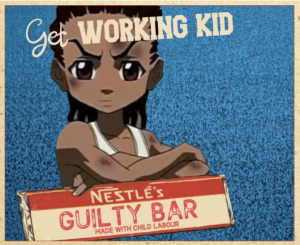Welcome to UBC Blogs. This is your first post. Edit or delete it, then start blogging!
-
Recent Posts
Recent Comments
Archives
Categories
Welcome to UBC Blogs. This is your first post. Edit or delete it, then start blogging!

The Milkybar Kid is a Nestlé mascot which has been used to promote their Milkybar product in advertisements since 1961. Although the Milkybar is marketed towards children, the advertisements that revolve around it remain saturated with subliminal messages about culture (especially in relation to children). For instance, up until 2010 the Milkybar Kid was portrayed as someone who is exclusively white, blond, and male. In addition, the Milkybar Kid is depicted as a child who is strong, tough, acts as a leader, and loved by all other children. As one would expect from someone of this nature, in advertisements, you will often find the Milkybar kid in conflict with malevolent adults acting as a hero, defeating adults easily, protecting other children and then, finally, distributing Milkybars to those he saves. After the narrative surrounding the Milkybar Kid character is established, a narrator will often comment about how the “Milkybar Kid only eats what’s right”.
In today’s context, chocolate is mainly treated as a delicacy. People who are purchasing chocolate are usually doing so as a luxury as opposed to purchasing it to function as food for survival. Therefore, the value of chocolate for the average consumer transcends its functional or use value, and instead often times depends on the arbitrary meanings which encompass it. It is clear that Nestlé is aware of this, as they focus their advertisements around the idea of the Milkybar Kid and not the product itself. Through doing this, they market ideas of culture and children with hopes that they become associated with their product as this will add the most value to their product. Conclusively, through their advertisements, Nestlé does not aim to sell you this product as food but rather because it is ‘what is good for kids’, ‘what tough kids eat’, ‘what kids love’ etc.

In my culture jam assignment, I aimed to highlight the irony of Nestlé itself marketing their product as an item that is good for children, or which children should want. This is ironic, because Nestlé has been found on numerous occasions to be utilizing child labour on their cocoa farms. For instance, in 2013 the Fair Labor Association led an investigation that found child workers at 7% of Nestlé’s West African cocoa farms. Children in these plantations have claimed to be “whipped, beaten and forced to work for 14 hours a day before retiring to dank, dark rooms without windows to rest” and in one case a child recounted how child workers who tried to flee would have their feet sliced open by guards. By changing the header of the graphic from “The Milkybar Kid” to “Get working kid”, the name of the bar to “Guilty Bar”, and including the product is “Made with child labour” I aimed to showcase this issue as the forefront of my project. Additionally, I decided to change the central character as someone who has a darker skin tone. I made this decision to add contrast to having a white male character as the default main character which is prominent in western culture. Furthermore, by portraying the character as darker toned I hoped to illustrate how it is usually minorities (non-white) groups who are victims of unethical business practice. Similarly, he is shown with injuries to emphasize the abuse child workers face under Nestlé to produce their chocolate bars.
Ultimately in this project I hope to raise awareness amongst consumers. Often times a product can be advertised promoting certain ideas, such as a product being “good for” or “loved by” children, when in fact the business could be partaking in practices that completely go against the idea their product stands for. Here I aim to show that purchasing products comes with much more than what is advertised and how this can lead to one supporting ideas other than what is presented by the company through purchasing their products.